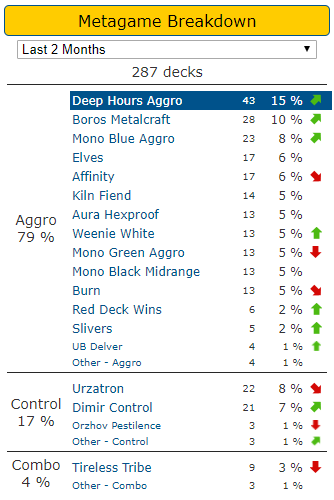Are you a Quiet Speculation member?
If not, now is a perfect time to join up! Our powerful tools, breaking-news analysis, and exclusive Discord channel will make sure you stay up to date and ahead of the curve.
Welcome back, readers!
It does seem like Pauper is the new "it" format, with lots of cards moving up dramatically. Sigmund hit on a few some weeks ago, but in a format as diverse as Pauper with as large a card pool there are plenty of options. Today I'm going to offer my own picks for Pauper.
First we want to look at the top decks in the format. The information below is taken from MTGTop8.

As is typical with Magic, the Pauper metagame does shift over time, so depending on when you're reading this is might look slightly different. However, the key takeaway is that aggro appears to be kind of the format.
The format is also extremely diverse. As the most popular deck, Izzet Delver occupies just 15% of the expected metagame, with everything dropping off after that. Tons of viable decks are here to explore.
This means we'll likely see a lot more players jumping onto the Pauper bandwagon and building decks. It definitely helps that the format is eternal so there's no danger of rotational drops in card prices, and the buy-in is so low that players can build a gauntlet for the price of a tier-one Standard deck.
Interestingly enough, my first pick for a Pauper spec opportunity is from a deck that only makes up 4% of the metagame: Mono-Black Midrange. Choking Sands is a single-print common from Mirage (i.e. the last and only printing was from 1996) that's often a four-of in the sideboard. Four-ofs in the board are just as important as those in the main, and Mono-Black players will need copies of these.
Currently they're sitting under $0.5, with many in the $0.25-$0.35 range. I can easily see this card doubling up without much effort given how every copy is 22 years old.
A single-print card from Conspiracy: Take the Crown. Pauper is a format in which true card advantage isn't all that readily available, especially in mono-black decks. Becoming the monarch can be a fantastic source of card advantage, especially in a deck full of one-for-ones.
Foils of this card have already spiked hard, but regular versions are sitting around $0.5, and it's typically played as at least a two-of (and possibly more in the board) of many of the mono-black midrange decks. The Conspiracy sets as a whole tend to get drafted a lot when they first come out and then quickly dry up. This means not nearly as much product is opened, and thus not nearly as much enters the supply.
This one's quite a bit newer than our first spec, however, it's another single-printing that's played as a four-of in Pauper Affinity (currently about 6% of the meta). Recently we saw the foil price spike from $1 to around $9-$10, though that looks like a buyout that has since calmed down. The point is that the regular version is played a lot and can still be had extremely cheaply.
Dragon's Maze was a pretty awful set. It had a single valuable card for most of its Standard existence (Voice of Resurgence), and boxes can still be purchased dirt cheap online as they continue to gather dust wherever they are stored.
Now Dragon's Maze did occur after Zendikar (which is when we had an explosion in the playerbase) so the print run was likely very large. Even as a four-of in the Kiln Fiend deck, I don't think the regular version can jump a ton. But foils can be found for about $1, and I imagine the number floating around is a lot smaller than one might think simply because of how little Dragon's Maze was opened compared to the rest of Return to Ravnica block.
Pauper Elves plays this card as a common replacement for Heritage Druid. Yet again we have a four-of in a strong deck with only a single printing (from Onslaught, which means all copies are at least 16 years old).
Foils on this card are already $5-plus, and they've been this high for two years now (so it isn't buyout driven). Onslaught was a popular block, thanks in large part to the introduction of fetchlands, so a lot of it was opened—but that was a long time ago and the playerbase has expanded greatly since then. I think this could easily be a $1-plus card if Pauper demand continues to grow and it dodges a reprint.
Another pick from Pauper Elves, Elvish Vanguard is a relatively new addition to the deck thanks to getting downgraded from rare all the way down to common in Eternal Masters.
Foil copies from Eternal Masters are about the same price as the regular version and I like them as a cheap pickup with a lot of potential; though remember that there are a lot more foils from Masters sets thanks to each pack always having one. Original Onslaught foils are closer to $5 each (though I'd argue their artwork is better and they are much rarer to boot).
The original version of Thought Scour that could only target yourself was printed back in 2002 in Judgment. We've seen how powerful self-mill can be when stapled to a cantrip thanks in large part to the delve mechanic.
Yet again this is a single printing, typically a two- or three-of in most of the UB Delver lists. It definitely feels like it could triple up from its current price of around $0.3 and perhaps even break the $1 mark.
While likely the weakest of the creatures in the UR Delver lists, this is a four-of from Origins. While that set wasn't printed that long ago, it's a core set which generally means fewer copies, and Miscreant isn't likely to be picked out of bulk all that often.
The current price is misleadingly low, as all available "cheap" copies come with additional shipping cost. That means that to actually purchase a set of four of these off TCGplayer you're likely going to have to pay $0.5 or more per copy.
Can Selling Commons Be Profitable?
I have run the numbers previously with regards to costs of selling on TCGplayer, and cards that sell for $2 or less net very little—in fact anything below around $1.12 nets a loss. To compound this problem, the price ceiling on a lot of Pauper cards is relatively low, thanks again to them all being commons. So the question arises, how do we actually make money here?
One benefit to Pauper speculation is that, more often than not, you paid practically nothing for a lot of these cards. I buy a lot of bulk, so I've gotten a ton of these new Pauper staples at $0.003 each. So the profit percentage can be massive, assuming we can find a way to unload any of these cards.
One option that I've used numerous times is to buylist them, typically at a GP. The challenge here is that most stores don't offer a very aggressive spread on commons—they, too, likely can dig them out of bulk they've purchased, so they're paying you merely to save them the hassle. So while I won't sell $10-plus cards when the spread is below 65%, I don't worry about 50% spreads on commons—after all, if I get $0.25 on a card I paid $0.003 for, my profit margin is still 823%.
There is also a lot more risk of the price completely tanking with a reprint. If you think rare reprints are bad, look at the price of Spell Pierce—it used to be a $2 common you could buylist for $1.25, and now it's a dime. The other challenge is that while the whole Pauper format seems to have cards jumping left and right, most of them are simply going from bulk to $1 (or less)—and buylists seem to be very slow to respond to a lot of these jumps.
One method is to sell playsets of these cards on Facebook (thus reducing your profit loss due to fees) and making sure that the shipping cost stays reigned in.
I've also put together a Pauper trade binder full of the top cards for each color, with the idea that if local players want to get into the format I can trade them a lot of smaller cards for more expensive liquid cards. I haven't had a chance to break this binder out yet—I'm still in the building stages—but I expect it will be worthwhile given how many local players have started asking about Pauper cards and decks on my local Facebook groups.
You can also post them up on TCGplayer in multiples of four and hope that players buy more than one at a time. I've had some luck with this the past, though there isn't a guarantee on that one.














So what was the second spec? I think I might be missing part of the article?
There appears to be an issue with the images and links missing;
The specs are;
Choking Sands
Thorn of the Black Rose
Carapace Forger
Nivix Cyclops
Birchlore Ranger
Elvish Vanguard
Mental Note
Faerie Miscreant
That binder is a fantastic idea. It’s the IRL version of “You might also like.”